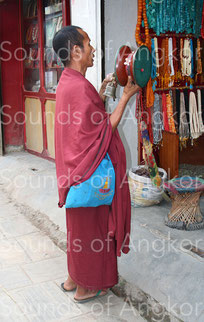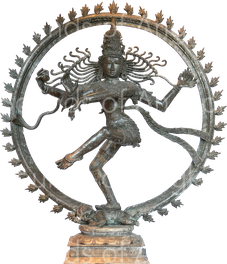Last update: December 5, 2023
The rattle drum was an object used by religious officiants. Today, it is still played by Tibetan Buddhist monks in the form of a wooden hourglass reminiscent of the two skulls joined together by their summits, formerly in common use.
No representation was noticed in Khmer iconography. Thanks to epigraphy, we know with certainty two Sanskrit names for the rattle drum - ḍamarin and ḍamaru - but not its name in Old Khmer.
The rattle drum in Asia
Attribute of the Hindu god Śiva, the rattle drum, also called whipping balls drum, appears in one of his hands when it is represented in its cosmic aspect Śiva-Naṭarāja or “King of the dance”.
In Tibet, Buddhists use it during their ceremonies.
In Nepal, Newar Buddhists and street vendors in the Kathmandu Valley still use it.
Frame rattle drums
We distinguish in Cambodia, for the Angkorian period, two types of rattle drums: frame ones and hourglass shape ones. A frame drum is a drum than thickness of the soundbox is less than its diameter. Their shape differs from the hourglass of Śiva-Naṭarāja. Their decor is truly Khmer and they have a handle. Several instruments of this type, in bronze, have come down to us whole or fragmented. Today they belong to institutions or private collections.
A frame rattle drum at the Russian Market (Phnom Penh)
The opposite instrument was on sale at the Russian market (phsaar Tuol Tom Pong) in Phnom Penh in 2012. Its exact provenance is unknown. Appraised by the National Museum of Cambodia, it was immediately reported to the seller on the pretext that it was a fake! We believe on the contrary that it is an authentic instrument given the relationship between the complexity of its manufacture and the ridiculous price at which it was offered. Indeed, when it is necessary to manufacture such an object, its cost is higher. Today it has disappeared from traffic but we have had time to photograph it.
Its top is adorned with a button-shaped lotus flower made up of thin bronze leaves superimposed like real petals. The center of the circumference of the soundbox is lined with bells. The two membranes were attached using a set of tubular loops. The top of the handle is decorated with two Naga. We do not see rings where the whipping balls should have been attached.
A frame rattle drum at the Vat Reach Bo (Siem Reap)
Another frame rattle drum belongs to the Vat Reach Bo archaeological museum in Siem Reap. Only the frame remains. In the central hole came a handle. Two surrounding rows of small holes allowed to nail the skin. Two rings secured to the soundbox received the whipping balls. It is referenced 2007-1-2129.
The frame rattle drum of the Musée Guimet
The frame rattle drum of the Guimet Museum is, to our knowledge, the most prestigious of all the instruments found in authenticated excavations. It is surmounted by a large male figure sitting cross-legged, surrounded by four others, female and smaller, holding a lotus flower in bud in their hands. The outside of the sounding board is decorated with rows of denticules. The two circular rims have a series of holes for fixing the membranes. Two lateral rings forming the beak of two Garuda received the wires connected to the whipping balls. At the foot of each Garuda is a nāga.
Sounds of Angkor reconstructed this object in 2019-2020 using the damaru from the National Museum in Bangkok as inspiration for the final assembly (see below).

The frame rattle drum of the National Museum of Bangkok

This Khmer instrument belongs to the National Museum of Bangkok. It is called glong banthoh (กลอง บัณเฑาะว์) in Thai.
The top part, the soundbox and part of the handle surmounted by four Garuda are in bronze. The piece between the soundbox and the top is made of wood, as is the fitted handle. The skin (goat or doe?) Is fixed with metal nails. The whipping balls consist of two polyhedral stones.
The set measures 57.5 cm.
To play, the officiant had to grasp the part including the Garuda and wave the balls in a rotational movement.
The hourglass-shaped rattle drum of the Vat Reach Bo (Siem reap)
Another rattle-drum, hourglass-shaped, also belongs to the archaeological collection of Wat Reach Bo in Siem Reap. At the time of its study by Sounds of Angkor, it was in two parts identified by two references. The comparison of the two fragments and the identification of this object as a rattle-drum belongs to the Sounds of Angkor. Its surface is covered with lotiform decorations. At the present time (2018), it seems to have disappeared from the collections...












